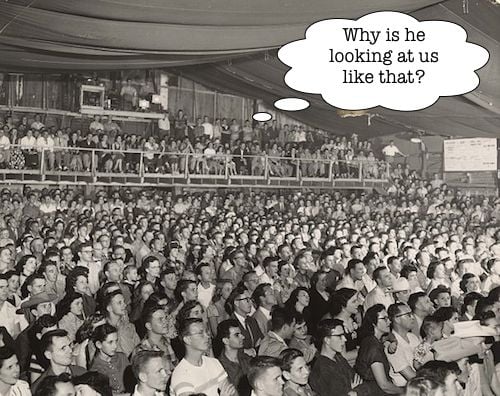When writing a speech, it’s second nature to think about the audience. The presenter keeps the audience foremost in mind when deciding how to formulate the speech from the subject to the structure to the tone.
Some people get so wrapped up in thinking about the people listening to their speech that they break out in cold sweats and resort to imagining the audience naked in order to calm their nerves.
Just as when delivering a speech, you should be thinking about your audience when you write just about every essay.
No, I don’t mean thinking about them naked. Unless your target audience is nudists, then you can think about them naked. I digress. Let’s move on.
Seriously, stop thinking about naked people reading your essay! (You know who you are.)

Pants on or pants off, it is important to understand who will be reading your essay, because writing for an audience makes your essay better.
What Is an Audience?
Just like there is an intended audience for performances, such as plays, films, and concerts, there is an intended audience for your essay–specifically, whoever will be reading it.
It’s not quite that simple though. Your audience falls into a couple different groups. Understanding these two audiences can affect some of the writing decisions you make.
Actual audience
The actual audience is whoever will actually be reading your paper. (You see why we call it an actual audience?) For many of you, this will be your teacher or professor, but for others it could be a friend, your boss, or a member of an admissions staff.
Understanding the person or persons behind the eyes that will actually (you see?) be on your paper can help you to gear your writing toward their sensibilities.
Intended audience
The intended audience is the group of people that you intend (SEE?) to address in your writing. These are the people who you are targeting with your message, even if they never actually read your essay. This tends to be an entire demographic of people.
For instance, you might write an essay for your political science class claiming that American politicians should learn a thing or nine from Uruguayan President Pepe Mujica. Your intended audience would be American politicians, yet your actual audience might only be your poli-sci professor.
It is important to understand both of these audiences before undertaking the formulation of your essay, as being aware of both can influence many aspects of your writing and improve it in the process.
Defining Your Audience
Does this really matter?
If we’ve already established that the only person actually reading your paper is your professor, then what’s the point of thinking about an imaginary audience?
Good question.
The answer is your teacher is going to be thinking about that audience when she reads your paper.
When grading an argumentative essay, teachers try to put themselves in the shoes of your intended audience. If your teachers believe your essay on global warming wouldn’t be convincing to a polar bear riding an ice cube, then you can expect to lose points.

On the other hand, clearly and concisely writing for an audience will take your essay to the next level.
But don’t forget the actual audience. Understanding the beliefs and sensibilities of your actual reader can greatly affect what is written in your paper.
I would never suggest pandering to the opinions of your reader, but those opinions will, nevertheless, affect the way you approach your subject.
Imagine writing a review of a class. How would you write it if the reader was a classmate? Now, would it be different if the reader was the teacher? Most likely.
In the end, it is about reaching your audience in the best possible way.
Define your audience early
Because of the sweeping effects your audience can have on your writing, it is important to analyze both your intended and actual audiences early in the writing process. So, I suggest always including an audience analysis as part of your prewriting process.
Before writing, before even outlining your writing, you should decide who your intended audience will be and how you can approach them in a meaningful way. These questions can help you to define who you are writing for:
- Who does my subject affect?
- What specific group within these people do I want to target?
- Why do I want to target them?
- If I’m hoping to change their opinion, how can I approach it in a way that convinces them?
- What is their point of view on my topic?
- Is there a specific structure that would best captivate my audience on this subject?
- What does the audience want or need? Can I use those desires in my favor?
- Is there anything that should be avoided, as to not offend or turn off the reader?
- What is my goal? What do I want the audience to feel or learn? How do I want to affect them?
The goal of these questions is to further and further narrow your audience. Writing for a general group can lead to generalizations in your writing, which won’t have the desired effect on either your intended or actual reader.
But if you are able to narrow your focus to a specific group of readers and decide how best to approach them, you have a better chance of reaching them in a meaningful way. These questions can help you get to that point.
Once you are there, you will be ready to write.
Writing for an Audience
Clarity
As a general rule of thumb, the more focused your writing is, the greater weight it will carry.
The danger of not visualizing your audience during the writing process is that your paper can become too broad and lack focus and purpose. As a teacher and editor, I’ve read many rambling papers that lack focus. It gives me, the actual reader in this case, the distinct feeling that the writer was more concerned with accumulating words on the paper than making a point.
This is not good.
Instead, if you visualize real people in your audience taking in the essay, and focus on what they want and need to read, your writing will focus on the most important aspects. All decisions about what to include or how to word a sentence will be answered by a simple question:
What is best for my audience?
This clarity of purpose will lead to clarity in your writing.
Content
The choices you make about tone, vocabulary, and the examples to be used in your paper will be greatly affected by the audience you are targeting.
When Stephen Hawking wrote A Brief History of Time, his intended audience was not physicists, but laymen. If he had ignored this fact, the book would have went over most people’s heads.
Instead, Hawking carefully chose the vocabulary and examples to be used throughout the book, formulating it with his audience in mind, leading to the sale of over 10 million copies.
Take your audience for a ride
Establish a relationship with your readers from the very beginning. One of the purposes of the introduction is to establish a relationship with the reader. Set the tone. Pull them in. Make them feel like they are a part of your essay.
But don’t go too quickly. If your goal is to convince anti-drug activists that drug prohibition should be abolished, you probably shouldn’t start by saying, “Drugs should be legal.”
Instead, you could first acknowledge that your hope is for drugs to be eliminated from society, which is a goal you share with your audience. Then, progress to an examination of how you believe that mutual goal could be best accomplished.
Make sure you keep your audience in mind every step of the way. Think about how they will feel as they read your paper. Formulate meaningful transitions that connect your ideas in a way that keeps the readers moving in the direction you want–towards your intended goal.
And, don’t forget about your audience in the conclusion. Perhaps, you’ve already made your point in the body of your essay, but the conclusion offers a unique opportunity to reinforce why the subject is important and how it can positively affect the reader moving forward.
Ensuring You’ve Reached Your Audience
I can’t reiterate this enough: Writing is revision.
New writers consistently fall into the trap of thinking that an essay is finished after writing the conclusion.
It’s not.
If you turn in that first draft, you may receive a score that is good, but why settle for good? Go for the gusto. Don’t settle for anything less than the best your essay can be.
Here are some tips for tackling the revision process in relation to writing for an audience:
Save and walk away
Once you’ve finished your first draft, save your document, and then just walk away from it for a while. Go read an unrelated book, meet up with friends, have a beer or coffee.
If you have time, let your essay simmer on your laptop for a day or two. Forget about it a bit. Then, come back to it with your audience in mind.
I promise, you will notice things that slipped under the radar the first time through.
Method revision
After taking that time away from your paper and clearing your head, don’t come back to it superficially. Like I mentioned above, you should approach the revision process with your audience in mind.
So, try to really get into your audience’s head before returning. Think like them. Foster their perspective before coming back to the essay.
For example, Daniel Day-Lewis, perhaps the greatest living actor, is an extreme method actor. He gets completely into each role, tricking himself into believing he is the character.
For his role as John Proctor in The Crucible, he even adopted 17th century hygiene habits for the entirety of the movie shoot.

Now, that is a bit extreme, but you get the idea. Also, if your essay is about nudists, please disregard this last section.
If not, a little method revision can go a long way when writing for an audience.
A little help from a friend
I suggest first revising your paper on your own. Once you have a second draft in your hand, a new set of eyes can go a long way towards completing a final draft.
Obviously, the best possible person to read over your paper is someone who understands the target audience, perhaps even someone who belongs to that audience. This could be a friend, a family member, or a classmate.
Another great option is a professional editor. The editors at Kibin.com have a wealth of experience editing essays, so they can quickly spot the mistakes in focus, clarity, and content that can cause you to lose your audience. Just be sure to include a note about your target audience when you upload your document.
Although it is only part of the writing process, writing for an audience is an important aspect that often gets overlooked. You will be surprised by how engaging your essay will be when you take the time to think about who will be reading it.